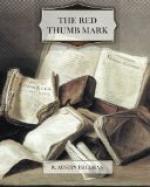“None whatever; for the reason that there would be no difference to detect.”
“But you have stated, quite positively, that the thumb-print on this paper is a forgery. Now, if the forged print is indistinguishable from the original, how are you able to be certain that this particular print is a forgery?”
“I was speaking of what is possible with due care, but, obviously, a forger might, through inadvertence, fail to produce an absolute facsimile and then detection would be possible. That is what has happened in the present case. The forged print is not an absolute facsimile of the true print. There is a slight discrepancy. But, in addition to this, the paper bears intrinsic evidence that the thumb-print on it is a forgery.” “We will consider that evidence presently, Dr. Thorndyke. To return to the possibility of forging a finger-print, can you explain to us, without being too technical, by what methods it would be possible to produce such a stamp as you have referred to?”
“There are two principal methods that suggest themselves to me. The first, which is rather crude though easy to carry out, consists in taking an actual cast of the end of the finger. A mould would be made by pressing the finger into some plastic material, such as fine modelling clay or hot sealing wax, and then, by pouring a warm solution of gelatine into the mould, and allowing it to cool and solidify, a cast would be produced which would yield very perfect finger-prints. But this method would, as a rule, be useless for the purpose of the forger, as it could not, ordinarily, be carried out without the knowledge of the victim; though in the case of dead bodies and persons asleep or unconscious or under an anaesthetic, it could be practised with success, and would offer the advantage of requiring practically no technical skill or knowledge and no special appliances. The second method, which is much more efficient, and is the one, I have no doubt, that has been used in the present instance, requires more knowledge and skill.
“In the first place it is necessary to obtain possession of, or access to, a genuine finger-print. Of this finger-print a photograph is taken, or rather, a photographic negative, which for this purpose requires to be taken on a reversed plate, and the negative is put into a special printing frame, with a plate of gelatine which has been treated with potassium bichromate, and the frame is exposed to light.
“Now gelatine treated in this way—chromicized gelatine, as it is called—has a very peculiar property. Ordinary gelatine, as is well known, is easily dissolved in hot water, and chromicized gelatine is also soluble in hot water as long as it is not exposed to light; but on being exposed to light, it undergoes a change and is no longer capable of being dissolved in hot water. Now the plate of chromicized gelatine under the negative is protected from the light by the opaque parts of the negative, whereas




